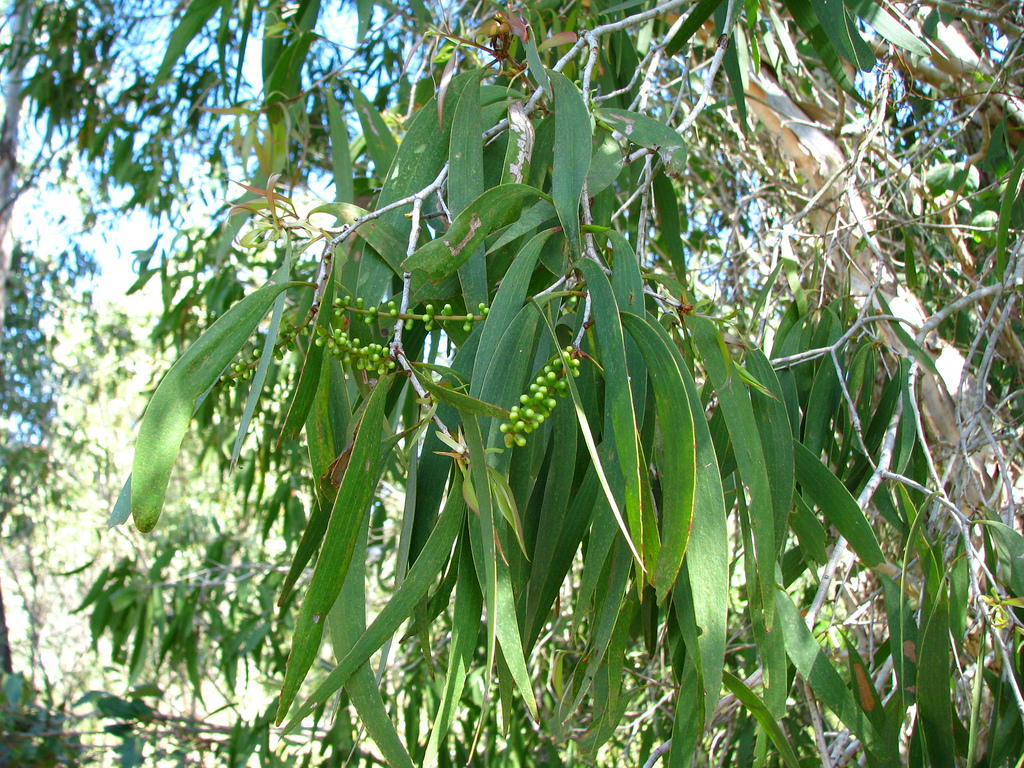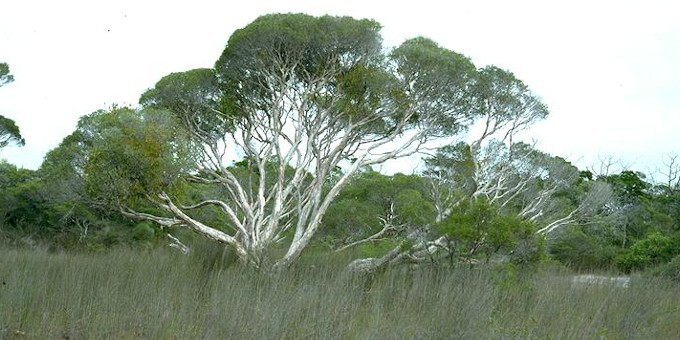Cajeput oil (Melaleuca leucadendron) stems from the distillation of the fresh leaves of a beautiful strong tree with a bark resembling the bark of the Birch tree. It grows wild or cultivated in South East Asia, but also in India and Northern Australia. The oil is produced all year long with help of rural mobile field stills in Vietnam and in Indonesia. Hydro-distillation rather than steam distillation is common – the simplified form of original distillation by which the leaves are just boilt in water to release the oil. The oil, if it is authentic, has to “bubble up” when shaken. The yield lies between 0,5 to 2,5 %. The Moluccan islands, belonging to Indonesia, especially Bouru and Banda, and Java are the main production areas.
The genus “Melaleuca” belongs to the Myrtaceae family and is widespread on Earth: It provides other popular essential oils such as Tea Tree and Niaouli for example. The name originates from “kayu putih” in Malay language meaning “white tree”. The botanical name “Melaleuca” stems from the Greek language and means black (mela) and white (leuca) referring to the dark/white trunks of this special plant group. And again in “leucadendra” we have the name for “white” (leuca) and “tree” (dendron). The unrectified (not re-distilled) oils from Indonesia are usually slightly greenish-brownish in colour, rectified oils can be colourless to green. Biochemically the oxide 1,8-cineole (eucalyptol) prevails. Other compounds are ?-caryophyllene, ?- and ?-pinene, limonene, viridiflorol, nerolidol, ?-terpineol. Cajeput’s odour is fresh sweetish-green, also camphorous, somehow similar to that of Eucalyptus, but softer, rounder, and in its effect less irritating to the bronchies than Eucalyptus globulus.

Bring the “wind” back to the system
Cajeput‘s properties on the “aerial” system of our physiology, the lungs, the sinus are, etc. are remarkable! Such oil is good to strengthen a constricted or cramped „Vata“ element (Ayurveda) and opens up the flow between spirit and matter, consciousness and physiology. In Alchemy and also in Anthroposophic understanding leaves are connected to “Mercurius”. His pulsations transmit the energies of the root, the world of minerals (Sal) to the energies of the flower (Sulfur) and vice versa. This has to do with movement, rhythm, expansion, and contraction, etc. When the leaves “breathe green” all life on Earth breathes. Yes, glory to the leaves and the leaf oils! With their rhythmic “inhaling” of carbon dioxide and “exhaling” oxygen their connection with our own rhythmic system, the lungs, and the heart, is obvious. Leaves mediate between the roots and the flowers/fruits in the plant – and their essential oils mediate between the lower and upper organs and energy centers in our own physiology – but also between the physical and the non-physical energies of our system.
There is a deep connection between the pulsations of our heart, the rhythm of our breath, and our thoughts and emotions. Feeling well also means we are in tune with our “inner circulation”. Feeling well means also: we nourish ourselves – through our heartbeat and breath – with harmonious thinking, leaving aside the temptations to get stuck in the stress and strain of our outer and inner worlds.
Leaf oils, in their “chlorophyllic” nature, infuse us with new vitality and tonus enabling also our blood to be energized and purified. The secondary effect of this impact is the revitalization and strengthening of our immune system which leads to faster healing and a more positive outlook on life when we are weak or sick. No wonder that with the help of the subtle pranic energy of a Cajeput oil “under our nose” 🙂 we can have – as said above – an influence on our VATA dosha, the major potential imbalance factor according to Ayurveda reflecting in panic, anxieties, and stress-induced health problems.
As we understand: Breath is the mediator between the subtle and the gross – our respiratory system (re-spiriting system?) is essentially a system of exchange. It is therefore important to recur to the oxidic actors in Nature such as for example the Melaleuca group or the Eucalyptus, Ravintsara, Myrtle oils, etc. in order to empower the element of movement in the body and bestow balance.
With this, Cajeput oil is also highly expectorant and therefore, a typical winter oil, that is a special medicine for the colder or inter-mediate seasons. It has very good anti-microbial properties making it a good choice for preventive room fragrancing and for treatment of catarrh, coughing, laryngitis, and other problems of the respiratory tract including also asthma, sinusitis… and COVID !

Research studies for the COVID crisis –
Inactivation of airborne germs etc.
It is clear that the use of essential oils due to their volatile nature – and especially those which are “breath-connected” should be the no. ONE treatment during the present Covid-crisis. And this particularly via the use of aerosol equipments such as aroma diffusers etc. which are largely and inexpensively available in the market. Unfortunately – and for numerous reasons – this is not collectively explained nor promoted. We could ask ourselves WHY…
Here a study of the “American Association for Aerosol Research” already published in 2012
“Our previous studies demonstrated that precoating of filter fibers with biologically active Tea tree oil (TTO) enhances physical collection efficiency of conventional heating, ventilation, and air conditioning (HVAC) filters, and provides cost-effective and rapid inactivation of captured bacterial and fungal particles on the filter surface. The main aim of this study was to investigate the antiviral activity of two natural disinfectants, i.e., Tea Tree Oil (TTO) and Eucalyptus oil (EUO), against the influenza virus captured onto the filter surface.
It was found that both tested oils possess strong antiviral properties when used as fiber coating materials, capable of inactivating captured microorganisms within 5–10 min of contact on the fiber surface. The antiviral activity of Tea Tree essential oil was also successfully challenged in aerosol form by mixing viable airborne viral particles with oil droplets in the rotational aerosol chamber. The results look very promising for further development of virus inactivating procedures and technologies for air quality applications.” (https://www.tandfonline.com/doi/full10.1080/02786826.2012.708948)
Or here :
“A study reported 221 phytochemical compounds and essential oils to be effective against severe acute respiratory syndrome-associated coronavirus (SARS-CoV) using a cell-based assay measuring SARS-CoV-induced cytopathogenic effect on Vero E6 cells. The main mechanism of antiviral effects of essential oils has been found to cause capsid (the protein shell of a virus enclosing its genetic material) disintegration and viral expansion which prevents the virus to infect host cells by adsorption via the capsid.” (https://pubmed.ncbi.nlm.nih.gov/33212200/)
Or here :
“The lack of toxicity and potent specific viral inhibitory activity suggests that many essential oils may be helpful as a possible anti-viral drug for control and treatment of influenza virus infection. They could potentially be used as a non-toxic way to cleanse surfaces or be dispersed to eliminate aerosolized virus particles in confined areas (like we experience at the moment during the Covid crisis). Since the oils are currently used as a food supplement, also oral administration, once the pharmacokinetics are determined, may provide therapeutic benefit during infection.” (cf. Shuhua Wu 1, Krupa B Patel, Leland J Booth, Jordan P Metcalf, Hsueh-Kung Lin, WenxiWu https://www.ncbi.nlm.nih.gov/pubmed/21078173)
“Administration of essential oils by aerosol therapy, smelling, inhalation, etc. is very helpful to intervene on severe pulmonary disorders i.e.
- Tuberculosis
- COPD (chronic obstructive pulmonary disease)
- lung cancers
- lung emphysema
- cystic fibrosis
Experience shows that it is good sometimes for the first session to ask for the presence of a therapist in order to make the right choice of essential oils, secure the use, and avoid a potential side effect (i.e. bronchial spasm). Place a few drops of essential oils on an aerosol filter or in a Venturi glass in a micro-diffuser to clear the pulmonary sphere of excessive phlegm or toxic particles of pollution and treat a severe infection directly from the mucus level of the lungs.” (cf. on this publication of Prof. Dietrich Wabner)

Other effects:
Cajeput belongs to “family medicine” in Indonesia. Mothers use to rub the oil in dilution on the chest of their children in case of cold and flu. The oil is also part of the composition of “Red Tiger Balm”, a well-known ointment derived from Chinese Pharmacopoeia used for muscular contractions. It was also used to relieve toothache, colic, rheumatism, and paralysis. As a protective balm Cajeput oil, similar to Niaouli oil, is also often applied today before x-ray treatment to prevent burning of the skin.
It can be used undiluted in case of insect bites and after burning of the skin. Also, genital herpes and hemorrhoids are treated with Cajeput oil. In dilution, it is a good oil for wound cleansing and an excellent skincare oil, especially for greasy skin types, having a tonifying cleansing effect on the skin. It is also mentioned as a remedy for problem scalps, and hair loss. Cajeput oil is therefore often used in formulas to treat acne, blisters also psoriasis, and other dermal problems like herpes, shingles, etc. Also ringing in the ears, otitis, rheumatism, intestinal and urinary infections, dysentery, insect bites, fever belong to the large catalog of problems where Cajeput oil can help. The oil is also recommended for easing veinal blood flow, making it useful to treat varicose veins.
It is also helpful in case of nausea, nervous diarrhea, and intestinal inflammation. And it is reported to be a good helper for cervical dysplasia, also painful or delayed periods. But due to its estrogen-like compounds, it should not be used during pregnancy.

Application:
- On herpes lesions or shingles apply 2 pure drops every hour during one day
- against radiotherapy, burns combine 2 drops of Cajeput with Niaouli
- A few drops in a bowl of hot water helps clear congested sinuses
- In local unction, diluted at 50% in vegetable oil in massage of the chest and upper back in case of catarrh
- In air diffusion in case of infectious epidemic
(cf. L’aromathérapie – Dominique Baudoux)
With its pain-relieving properties, particularly in combination with Peppermint, Lavender, and Basil oil, Cajeput oil is also very useful in case of neuralgia and headaches and good for easing muscular aching and stiffness.
A recipe for Gout:
- 25 drops Angelica root
- 10 drops Cajeput
- 12 drops Lavender Highland
- 3 drops Litsea cubeba
in: 30 ml St. John’s Wort/Olive oil (“Red oil”) and 20 ml Calophyllum oil (Tamanu) (Ruth v. Braunschweig)
A recipe for Nervous problems and migraine:
- Lavender: 1 drop
- Cajeput: 1 drop
- Clove bud: 1 drop
Dilute in sweet Almond oil: 10 to 15 drops Arnica or St John’s wort oil: 10 to 15 drops
Use: Gently massage your temples (T. Telphon)
Respiratory problems – decongestant for the nos:
- Angelica archangelica: 1 drop
- Sweet Basil or Aniseed: 1 drop
- Cajeput: 1 drop
Dilute in sweet Almond Oil (with a drop of Sea Buckthorn Oil): 5 ml
Use: Apply this solution to the nostrils and around the nose with a cotton bud or a clean finger. Also, rub it on the forehead and cheekbone. This mixture will also repair the damaged skin of the nostrils and can be. (Monika Werner)
Mouth ulcer:
- Clove bud: 1 drop
- Bay Laurel: 1 drop
- Cajeput: 1 drop
Calendula carrier oil: 3 drops
Apply 3 to 4 times a day this mixture on the lesion(s) for 3 days. (D. Festy)
Stretch marks prevention outside of pregnancy:
Do not use if you are pregnant or breastfeeding
- Cajeput: 1 ml
- Myrrh: 1 ml
- Rose Geranium: 1 ml
- Cistus: 1 ml
- Helichrysum: 1 ml
- Mandarin: 2 ml
Dilute in:
- Argan carrier oil: 5 ml
- Rosa mosqueta carrier oil: 15 ml
- Hazelnut carrier oil: 50 ml
1 application morning and evening on the areas at risk (D. Baudoux)
Testimonials:
“I have just tried this essential oil for a recent sinus infection and loved the immediate effect on clearing my sinuses. Will be part of my must-haves now.” (23/04/2019 by lidia R. from: Aromazone)
“I have a personal formula where I use it together with other essential oils in a preparation for pains of all kinds. This (Cajeput) is the main ingredient along with Juniper. (20/01/2019 par Chris O. from: Aromazone)
This oil is very effective for skin problems – blisters, boils, herpes labialis, atonic or burnt skin, acne, eczema, itching, psoriasis, mycosis…; to treat heavy legs, muscular pains. (from: Aromazone)

To conclude:
The famous oxide in Nature, 1,8-cineole (or eucalyptol) has its name from the Greek words “kine” = moving and “aeol” = wind. This oxide, being the major compound of Cajeput oil the association with the element air, as we saw, is obvious. Combining Cajeput oil with another “breathing oil” like mountain Hyssop, for example, an essential oil that has also a dominant presence of oxides (trans-linalool oxide), can even enhance its properties on the “aerial” system of our physiology, the lungs. As we saw, such oils are good to strengthen a constricted Vata element and open up the flow between spirit and matter, consciousness, physiology, and psychology. With psyche – meaning “breath” in greek!! – as the mediator between the subtle and the gross, it is important to recur to the oxidic actors in Nature in order to empower the dynamic elements and bestow balance to the system.
Many factors such as wrong diet, immobility during work or, on the contrary, too much mobility during traveling, “seasonal stress”, psychological or social problems, etc. may easily lead to respiratory cramping or congestion and therefore may need biochemical agents to open up the system. Phyto-oxides such as 1,8-cineole in Cajeput oil are wonderful helpers for this.

Cajeput oil stimulates our inner life force, assists us in putting us back into harmony, clears thoughts and emotions, and is a true helper for inner freedom and peace. With its special nature this beautiful exotic oil, hardly known to the West 50 years back, bestows tonus to the mind and refreshes our physiology.
A true companion to air out rigidity and breathe in space. A reliever of earthly pain – a fresh wind for the soul!